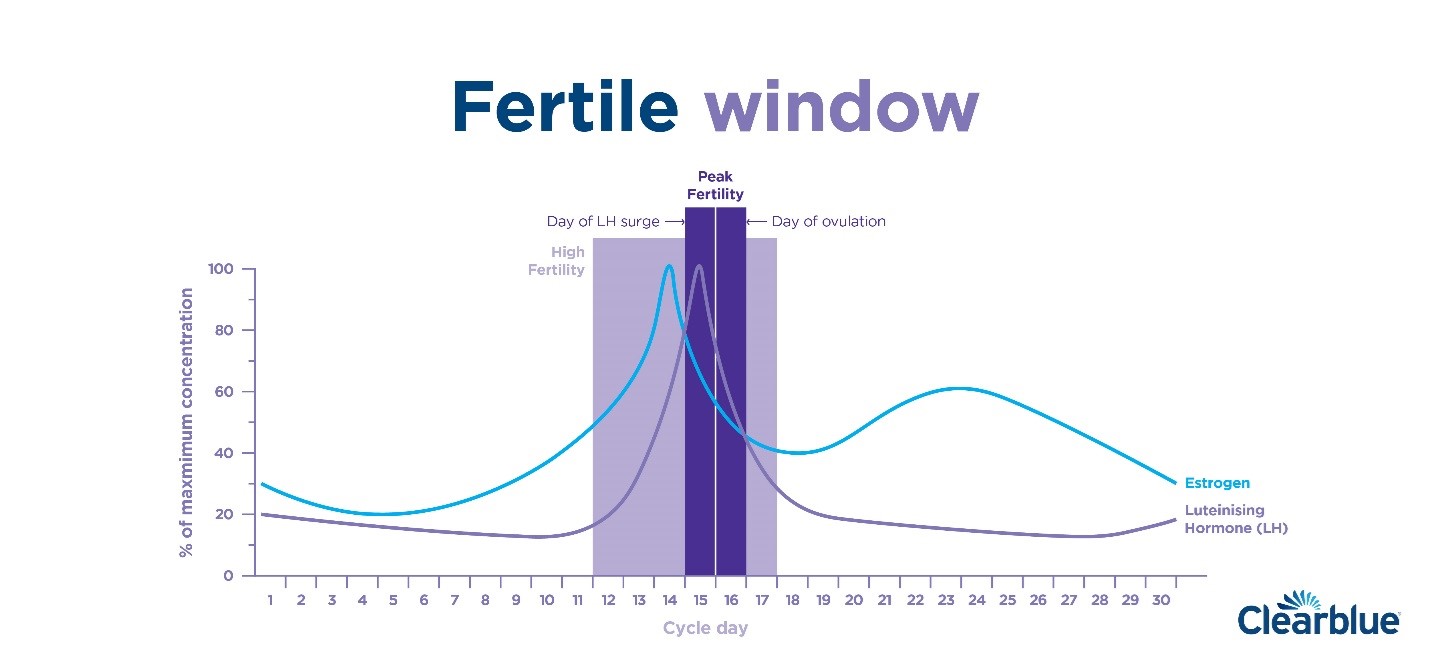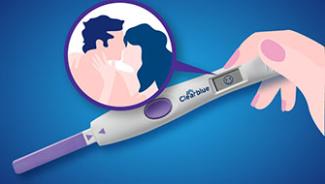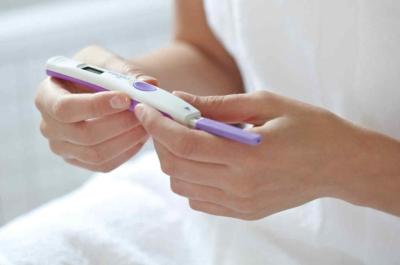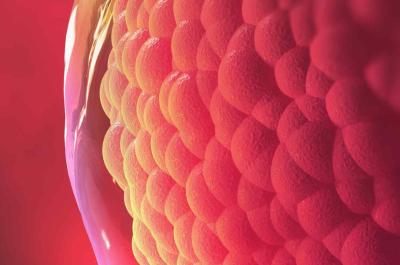
Do you know how long a menstrual cycle is? You may answer with the textbook 28 days, but a study of more than 30,000 women found that 87% had cycles that fell in the range of 23 to 35 days1. Perhaps you’re convinced your cycle runs like clockwork, but many women in the same study found their actual cycle lengths were different to what they initially thought they were, with 52% seeing a variation of up to 5 days between cycles. Read on to learn about how your fertility relates to your menstrual cycle, how long a menstrual cycle is, and why some women get irregular periods.
How can knowing about your menstrual cycle help you get pregnant?
Understanding your menstrual cycle can help you know when you are at your most fertile that month, so you can get the timing right for intercourse and be more likely to get pregnant. One in six couples in the UK have trouble conceiving1. An important reason for some couples failing to conceive is that they don’t have sex at the right time to coincide with the time of the cycle when a woman is fertile. The length of your menstrual cycle can give you a clue into when this fertile window is, but many women are unaware of the actual length of their menstrual cycle, or they don’t appreciate that their cycles can vary and so incorrectly calculate their fertile days. If you’re planning to get pregnant, then understanding your menstrual cycle and ovulation can help you get the timing right and may increase your chances of conception.
What happens during your menstrual cycle?
Your menstrual cycle is by definition a ‘cyclical process’ of roughly a month with the first day of menstruation (i.e., the start of your period) marking the beginning, and the day before your next period marking the end of one menstrual cycle. Here is what happens during a normal menstrual cycle:
- The ovaries get a chemical signal from follicle-stimulating hormone (FSH), causing some follicles (containing immature eggs) in the ovaries to start to develop.
- Eventually one egg becomes dominant and when it matures, the ovary releases the mature egg into the fallopian tube, where if sperm is present, the egg can become fertilised.
- At the same time as the ovary prepares to release an egg, the uterus (womb) lining begins to thicken in preparation to receive a fertilised egg.
- The egg travels down the fallopian tube.
- If the egg is not fertilised within 24 hours after ovulation, it dies and will eventually leave the body during your period.
- The womb lining comes away and leaves the body as menstrual blood.

Many assume that ovulation (when the egg is released by the ovary) occurs on a fixed day for certain cycle lengths, but studies show otherwise. For a woman with a 28-day cycle, it’s still possible for ovulation to happen any day over a 10-day time-period. Although textbook definitions put the day of ovulation at 14 days (in a typical 28 day cycle), studies have found you’re just as likely, or even more likely, to ovulate in the days after the textbook indicates. Only 20% women were found to ovulate on day 14, whereas 27.1% ovulated on day 15 and 21% day 16.
What have hormones got to do with it?
Hormones control the menstrual cycle, with important ones being estrogen, luteinising hormone (LH), follicle stimulating hormone (FSH) and progesterone.
At the beginning of the menstrual cycle, in the part known as the follicular phase, FSH stimulates a number of follicles in the ovaries to develop. Each follicle contains one egg. As the follicles develop, they produce estrogen, and as the level of estrogen increases, it causes the lining of the womb to thicken. High estrogen levels are also associated with the appearance of ‘sperm-friendly’ cervical mucus. The rise in estrogen eventually causes a sudden rise (or ‘surge’) of LH which occurs about 24 – 36 hours before ovulation (when the egg is released from the ovary).
After an egg has been released during ovulation, the former follicle becomes a mass of cells called the corpus luteum, which releases the hormone progesterone. As progesterone levels rise during the second half of the menstrual cycle, known as the luteal phase, as it helps the womb prepare for the implantation of a fertilised egg. If fertilisation does not happen, then the levels of estrogen and progesterone will fall, and your period will start.
What is a fertile window?
Your fertile window is the time in your menstrual cycle when you can get pregnant. The day before ovulation and the day you ovulate are known as your ‘peak fertile days’, but since sperm can survive for up to 5 days inside a woman’s body, you are also fertile on the few days before ovulation. Once an egg is released it will survive for up to 24 hours, so you remain fertile for this period too. Outside this fertile window, the chances of conceiving are highly unlikely.
Because many women miscalculate their cycle length, and as there is some natural variation, it’s easy to get your fertile window wrong. Many couples who are trying to conceive struggle to do simply because they get their timing wrong and have sex on the wrong days. As we have discussed before, the day of ovulation for a specific cycle length can still vary over a 10-day period. One way to better understand your fertile window is to take an ovulation test to see when you ovulate. An ovulation test works by identifying your LH surge, which happens 24 to 36 hours before you release an egg, so you need to take an ovulation test each day from the first day you are likely to ovulate until you see a surge. Some ovulation tests also identify the rise in estrogen which happens before the LH surge, so identifying additional high fertility days.

What is a menstrual cycle and how does age affect it?
You can think of your menstrual cycle as a biological calendar that starts from the first day of your period until the day before the start of the next period. Girls can get their first period from as early as 10 years old or as late as 16 years old, although 12 is the average age. When a woman goes through menopause, her periods stop, which usually happens in her late-forties to early-fifties.
Although fertility levels start to go down from the age of 35, until menopause there is still the chance a woman could get pregnant, as long as she has no other fertility issues. However, if you are under 35 and haven’t been able to conceive within a year (or within six months if you’re aged 35-40, or as soon as you start trying if you’re aged over 40), see your doctor.
A woman’s menstrual cycle is highly individual though, just like some women get their first period or go through menopause at different ages to other women, the length of the menstrual cycle will vary, too.
What is a normal menstrual cycle length?
You may have heard the textbook definition of the menstrual cycle is 28 days, and many women incorrectly believe that this applies to them. In fact, many women think they know their cycle length, but the numbers show that many don’t always get it right. A Clearblue study, which collected data from 32,595 women trying to conceive using the Connected Ovulation Test, provided important insights into how variable and personal menstrual cycles were, not just in variation from woman to woman, but also between cycles for the same woman. In the study, the cycle length recorded by the women was analysed. The actual data collected showed significant differences between what they thought their cycle length was and what it actually was.
When women were asked to record their cycle length the first time, 31.1% of women said they believed their cycle to be 28 days. The percentage of women who self-reported a 28-day cycle went down to 23.3% as they recorded more cycles with the app.

However, even this percentage of 28-day cycles proved to be an overestimation. The study used data from the Connected Ovulation Test System. The data from the ovulation tests showed that only 12.4% of women had an actual cycle length of 28 days.
Even though, 28 days was still the most common average cycle length within the range 17 to 35 days, it’s not as common as the textbook definition might lead you to believe. So, what counts as a normal, long or short menstrual cycle?
- A normal cycle falls between 21 and 35 days.
- A short cycle is one that is fewer than 21 days.
- A long cycle is one that is more than 35 days.
However, a woman may see variation in the number of days from cycle to cycle. This means, she may find it hard to get pregnant by determining her fertile window from using just a calendar. Even if a woman has menstrual cycles with little to no variation, predicting her fertile window can still be difficult as the day she ovulates may vary.
What causes long and short menstrual cycles?
Hormones, such as FSH, estrogen and progesterone, control each stage of your menstrual cycle. There is a link between short menstrual cycles and a higher concentration of estrogen in the follicular phase, and an earlier rise in FSH (follicle stimulating hormone). Longer cycles are also frequently connected to hormones, often with higher concentrations of the luteinising hormone (LH) and lower levels of estrogen in the follicular phase. Further, both long and short cycles can also be due to anovulation, which is when the ovary doesn’t release an egg that cycle.
What is an irregular period?
An irregular period is when the length of your menstrual cycle—the number of days between your periods—keeps changing. It could be that your periods come early, late or you skip them altogether.
In the Clearblue study, cycle lengths didn’t only vary between women, but even the same woman may have seen a variation from month to month. In fact, the study found that fewer than 1% of the women sampled had the same cycle length across four consecutive cycles, and 52.3% had cycle lengths that varied by five or more days1. So variable cycles and irregular periods are more common than you may think and are actually perfectly normal. If cycle length is the only information a woman is using to time when to have sex when she’s trying it get pregnant, she may not conceive as fast as she would like, as her fertile window may vary from one month to the next.
Saying that, although having some variability in the length of your cycle is normal, extreme irregularity in your cycles could point to an underlying medical reason that could affect fertility. Perimenopause or anovulation (when an ovary doesn’t release an egg) could be the reason behind these irregular periods, so talk to your doctor or gynaecologist if you have highly irregular periods.
Other causes of irregular or missed periods could include:
- Underlying reproductive disorder, like polycystic ovarian syndrome (PCOS) to PCOS article
- obesity
- an eating disorder
- too much exercise
- a thyroid disorder.
Why and how should you track your menstrual cycle if you’re trying to get pregnant?
Tracking your menstrual cycle over several months will give you a more accurate picture of your average cycle length, which is good to know as this helps you calculate the days when you can start ovulation testing.
An ovulation test can help you plan better if you want to get pregnant, as it will show when you have an LH surge, and there are even tests that also measure your estrogen levels so you get an even wider fertile window.
FAQs about your periods and fertility
How many days after your period are you most fertile?
This depends on length of your menstrual cycle and when you ovulate. If you ovulate on day 15, and your period ends on day 5, your fertility window begins on day 10 so 5 days after you finish your period. The fertile window starts before you ovulate as sperm can survive for up to 5 days after sex.
Do regular periods mean you are fertile?
Regular periods are a good sign that you are likely to be ovulating regularly.
However, other factors besides ovulation and regular periods that can affect fertility e.g. healthy fallopian tubes, endometriosis etc.
How many days a month are you fertile?
Once an egg is released, it can only survive for up to 24 hours, but since sperm can survive for up to 5 days, your fertility window is approximately 6 days long as you can have sex several days before you ovulate and still get pregnant. The best time to have sex is in the days leading up to ovulation and the day of ovulation itself. This fertile window may vary between women and even your cycles, so a simple way to know this is to take an ovulation test.
Can you get pregnant 5 days after your period starts?
It depends when you ovulate in your cycle. For example, if your period ends on day 5, and you ovulate on day 10 of your menstrual cycle there is a chance you could get pregnant 5 days after your period.
Can sperm survive in menstrual blood?
Yes, sperm can survive in the body for up to 5 days, and that includes in menstrual blood.
Can you get pregnant on non-fertile days?
An egg only survives for up to 24 hours after it’s been released. Once the egg dies, it cannot be fertilised, and you won’t be able to get pregnant that cycle.
The fertile window is longer than the 24 hours that the egg survives as sperm can live for up for 5 days after sex. The fertile window is, therefore, usually 6 days long.
If you are trying to get pregnant, ovulation tests can identify this fertile window during each cycle but must not be used for contraceptive use.
Menstrual cycles vary from women to women, and you may notice some difference in length if you track your periods. This variation is perfectly normal, but it can make it a little tricky to plan the right (most fertile) days to have sex if you are trying to get pregnant. You can take some of the guesswork out by using an ovulation test to know when your most fertile days are.
- Real-life insights on menstrual cycles and ovulation using big data, I. Soumpasis, B. Grace, S. Johnson, Human Reproduction Open, pp. 1-9 (2020)

Find your most fertile days
Ovulation tests are an accurate and simple way to identify your most fertile days to maximise your chances of getting pregnant.



